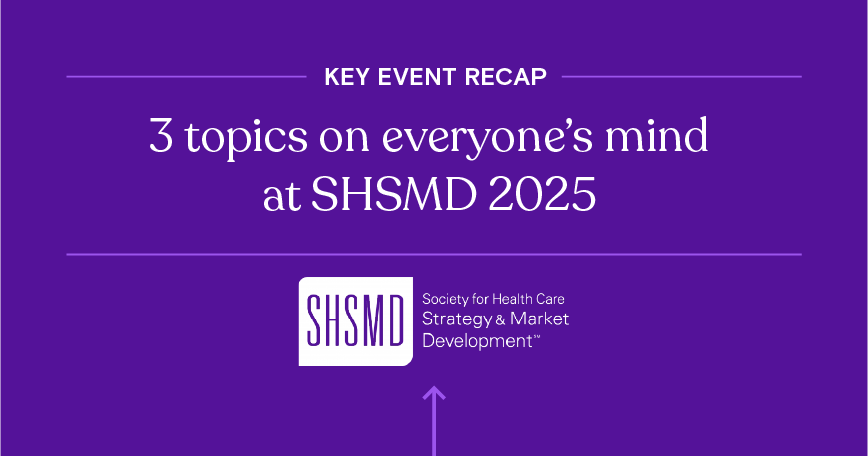The Society for Health Care Strategy & Market Development (SHSMD) brought its annual Connections conference to Dallas, Texas this year, drawing healthcare marketers, communications specialists, and strategy professionals together for three days of learning, networking, and problem-solving.
Definitive Healthcare took part in SHSMD Connections 2025, with team members Michael Dowd, Danna Dunn, Mike Julian, and Emilio Ruocco attending sessions, promoting our data and analytics solutions from our booth, and chatting with our industry peers about the challenges defining their day-to-day.
Last year’s SHSMD event left us with useful takeaways about healthcare innovation, engagement, and storytelling. This year, our team revisited a few familiar topics while also engaging in conversations about some very of-the-moment issues.
Here are the topics our team found themselves discussing the most at SHSMD 2025.
There’s an urgent need to do more with less budget
From marketing to IT to patient-facing care, no function in healthcare is immune to the growing financial pressures impacting the industry.
While budget wasn’t explicitly a top-line issue in this year’s programming, the troubling reality of ongoing fiscal headwinds undergirded nearly every exhibition hall conversation and learning session. We consistently heard that, across organizations, budgets are tightening while marketing and strategy teams are being asked to drive value even further.
How can teams do more with less?
Align long-term goals with near-term tactics
Great results begin with great planning. Setting realistic goals oriented around resource limitations and long-term strategic priorities can ensure everyone is working toward a desired endpoint while reducing waste and redundancy.
The planning process can be aided by robust, data-driven intelligence and market forecasting tools. Be sure to measure results continuously, and don’t be afraid to adjust course midyear, mid-quarter, or even mid-campaign.
Prioritize high-value reimbursement sources
Service line growth is a top concern for most provider organizations, but it’s not always clear whether resources should be allocated toward bread-and-butter service lines or those that are less utilized but involve higher-reimbursing encounters.
Comparing historical service line performance with projected outcomes based on prospective investments can provide some clarity, but to really see things clearly, you should seek market-level intelligence on prospective patients and competitors’ performance. Rather than examining volume and reimbursement rates alone, consider downstream qualitative metrics like length of stay, readmissions, and patient experiences. It may be a good time to reassess payor contracts, prioritizing those that tie reimbursement to value-based outcomes rather than fee-for-service volume.
Use technology to make budgets work smarter and harder
Automation can save time, effort, and spend across multiple functions, from scheduling to data entry to medical imaging. Marketing and strategy teams are no strangers to digital tools, but it’s still worth examining whether these teams are making the most of rising tech like generative AI, engagement campaign automation, and AI-assisted analytics and reporting tools.
Beyond freeing up talent and budget to allocate toward high-impact creative work, automating routine tasks can insulate staff from repetition and burnout, reducing the need for costly hiring and onboarding cycles.
It’s not easy to communicate marketing’s ROI to the C-suite
As budgets tighten, marketing teams are often the first on the chopping block. And marketing leaders tend to be among the first of the first, often to deleterious results—a phenomenon explored in-depth in the session “Is Rome Burning? The Future of CMOs,” as well as throughout several casual discussions at our booth and around the conference.
With the proverbial blade looming overhead, marketing professionals and leaders say they’re finding it more critical than ever (but no less challenging) to communicate their value to the C-suite.
Core marketing outcomes like brand reputation, awareness, and loyalty can be difficult to quantify, and it’s not always clear which channels or campaigns are most responsible for particular conversions. Factor in the length and complexity of the patient journey, with a variety of touchpoints and potential exits from and re-entries to a provider network, and the calculation becomes even more nuanced.
The right data can reveal the true value of marketing and simplify the process of demonstrating that value to key stakeholders. Here are a few examples:
- Social determinants of health (SDOH), consumer behavior, and health attribute data can inform segmentation strategies, enabling more effective engagement and clearer communication of ROI within specific micro-segments.
- Market-level procedure and diagnosis claims data help reveal the impact of service line and therapy area-focused campaigns compared to historical trends or competitors’ performance. They can also demonstrate the influence of key opinion leaders (KOLs) on patient and provider behaviors.
- Network intelligence built on claims and affiliations data shows the effect of marketing efforts on referral patterns, prescribing behavior, and patient outmigration.
Paired with smart analytics, visualization, and reporting tools, these insights can tell the story of who your marketing campaigns are reaching, how they’re contributing to organizational goals, and where new opportunities might be waiting.
The future of consumer engagement is clouded by regulatory uncertainty
Finding, segmenting, and reaching consumers is always easier with data. And while more data doesn’t necessarily equate to better outcomes, more complete data generally enables more accurate and personalized engagement.
However, cultural and regulatory attitudes around data security and privacy are evolving rapidly as technologies like wearables, patient portals, electronic health records, and artificial intelligence open new opportunities for use and misuse alike.
Navigating HIPAA compliance and patient privacy were the topics of SHSMD 2025 sessions like “Patient Privacy: Marketing & Digital Engagement Tactics & Advanced Strategies” and “Improving the Digital Patient Experience, One Search at a Time.” And we heard numerous attendees express their concerns that the engagement tactics of today might not drive results in a near future governed by novel and unforeseen guidelines.
Ransomware, phishing, spoofing, and other cyber-attacks targeting patient and organizational data are on the rise and deserve to be taken as seriously as regulatory compliance—the cost of PHI exposure, stolen credentials, federal penalization, and/or loss of accreditation certainly outweighs any potential ill-gotten gains from inappropriate or unsecured data usage.
Still, marketing and strategy teams are justified in being a little anxious about an uncertain regulatory future. Rules around third-party sharing, electronic security policies, patient disclosure, and data transmission are all likely to evolve as PHI is seen as increasingly valuable.
While we can’t predict the future, we suspect that certain data types will remain in play for healthcare organizations looking to personalize targeting and outreach: de-identified claims, reference data, health attributes, website traffic, channel preferences, and other non-identifying information types make for effective (and compliant) campaign guideposts.
Give marketing and strategy teams a boost with the right data
Whether you’re focused on getting more done on a tighter budget, demonstrating ROI to key stakeholders, or futureproofing your operations, having access to a wide variety of robust data sources is invaluable.
Acquiring, cleansing, certifying, and maintaining market-level data is costly and time-consuming. Definitive Healthcare does the hard part for you, integrating our continuously updated data into your internal workflow with no need for complex workarounds or manual upkeep.
Get data-driven clarity into your market, patient populations, competitors, and more. Sign up for a demo today.





